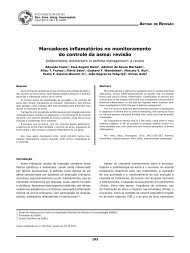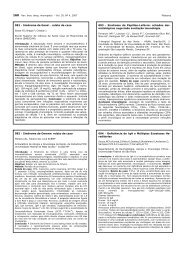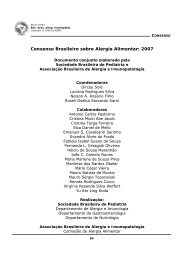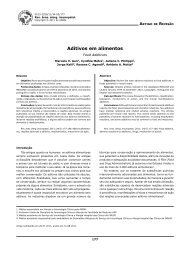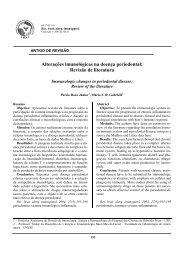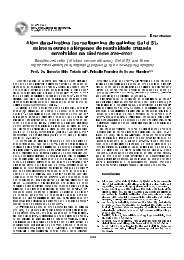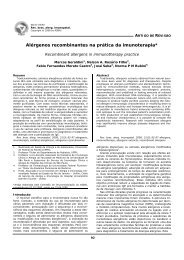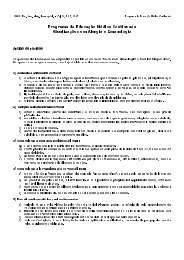001 - Novel mutation in nemo (IKBKG) causing hipohydrotic ...
001 - Novel mutation in nemo (IKBKG) causing hipohydrotic ...
001 - Novel mutation in nemo (IKBKG) causing hipohydrotic ...
You also want an ePaper? Increase the reach of your titles
YUMPU automatically turns print PDFs into web optimized ePapers that Google loves.
136 Rev. bras. alerg. imunopatol. – Vol. 30, Nº 4, 2007 Temas livres<br />
085 - Hereditary angioedema (HAE) <strong>in</strong> Brazil: registry<br />
of 120 cases<br />
Grumach AS, Pires Correia A, Valle S, França AT, P<strong>in</strong>to JA, Constant<strong>in</strong>o-Silva<br />
RN, Mansour E, Zollner R, Vilela MMS, Moyses TR,<br />
Andrade MEB, Fernandes FR, Tebyriçá J, Tebyriçá C, Jacob CM, Di<br />
Gesu R, Di Gesu G, Benedicto C, Geller M, Wolff PG, D, Duarte<br />
AJS.<br />
Dept of Dermatology, University of São Paulo (USP); Federal University<br />
of Rio de Janeiro; Federal University of M<strong>in</strong>as Gerais; University<br />
of Camp<strong>in</strong>as; University of Espirito Santo, Hospital do<br />
Servidor Público Estadual; Dept of Pediatrics, USP; Federal University<br />
of Rio Grande do Sul, Private Cl<strong>in</strong>ics.<br />
Background: HAE is caused by a quantitative or functional defect of C1 <strong>in</strong>hibitor<br />
(C1INH). This prote<strong>in</strong> acts <strong>in</strong> the control of Complement System activation and it is<br />
also <strong>in</strong>volved with coagulation, bradik<strong>in</strong><strong>in</strong> and fibr<strong>in</strong>olysis. Cl<strong>in</strong>ical manifestations<br />
<strong>in</strong>clude angioedema attacks affect<strong>in</strong>g subcutaneous, respiratory and<br />
gastro<strong>in</strong>test<strong>in</strong>al systems. The prevalence is estimated as 1:10000 or 50000<br />
<strong>in</strong>dividuals. There was no register of Brazilian cases until now.<br />
Objective: To describe the cl<strong>in</strong>ical and laboratorial characteristics of patients with<br />
HAE <strong>in</strong> follow up at referral centers for a primary immunodeficiencies <strong>in</strong> Brazil.<br />
Methods: A collaborative work<strong>in</strong>g group was established among specialized<br />
services and cl<strong>in</strong>ical and laboratorial data of 120 patients were collected. The<br />
follow<strong>in</strong>g parameters were evaluated: gender, age, first symptoms, age of<br />
diagnosis, ma<strong>in</strong> and unusual cl<strong>in</strong>ical manifestations, trigger<strong>in</strong>g factors, treatment,<br />
familial history and C1INH, C4 and CH50 values. Laboratorial diagnosis of C1 INH<br />
deficiency was confirmed <strong>in</strong> all patients.<br />
Results: There was predom<strong>in</strong>ance of females (80F:40M), median age=28 years<br />
(range: 1-70 y); the first symptoms were reported dur<strong>in</strong>g childhood (median=7 y)<br />
and diagnosis confirmed at a median age of 18 y. The identified trigger<strong>in</strong>g factors<br />
were: trauma (41/120), stress (22/120), menses (10/120), <strong>in</strong>fections (3/120) and<br />
exercise (2/120). Family history was positive <strong>in</strong> 91.7%. Subcutaneous edema was<br />
reported by 97%, abdom<strong>in</strong>al pa<strong>in</strong> by 43.1% and laryngeal edema by 25% of the<br />
patients. Additional compla<strong>in</strong>ts <strong>in</strong>cluded ur<strong>in</strong>ary retention, abdom<strong>in</strong>al surgery and<br />
headache. Median C1INH and C4 levels were 7,6 and 7 mg/dL. Danazol was the<br />
ma<strong>in</strong> therapy <strong>in</strong>stituted.<br />
Conclusion: Familial history was determ<strong>in</strong>ant for the HAE diagnosis. Although late<br />
diagnosis has been established, the first symptoms occurred dur<strong>in</strong>g the childhood.<br />
Uncommon trigger<strong>in</strong>g factors and symptoms were reported. Access to functional<br />
evaluation of C1INH is limited and C4 is a helpful screen<strong>in</strong>g test. With estimates of<br />
3,600 to 18,000 cases, HAE rema<strong>in</strong>s largely underdiagnosed <strong>in</strong> Brazil.<br />
086 - Síndrome da Poliendocr<strong>in</strong>opatia Autoimune-<br />
Candidíase-Distrofia Ectodérmica (APECED): Relato<br />
da primeira família brasileira com mutação homozigótica<br />
P326L no gene AIRE<br />
Dorna, MB 1 , Pieri PC 2 , Oliveira JB 3 , Pastor<strong>in</strong>o AC 1 , Carneiro-<br />
Sampaio, M 1 , Jacob CMA 1<br />
1<br />
Unidade de Alergia e Imunologia – Departamento de Pediatria –<br />
FMUSP;<br />
2<br />
Laboratório de Pediatria Clínica – LIM36 –<br />
Departamento de Pediatria – FMUSP;<br />
3<br />
Laboratório de<br />
Dermatologia e Imunodeficiências – LIM 56 - Departamento de<br />
Dermatologia –FMUSP<br />
Objetivo: Relato de família brasileira com dois filhos afetados<br />
pela síndrome APECED e mutação homozigótica no gene AIRE.<br />
Métodos: O defeito molecular foi identificado por amplificação<br />
dos 14 éxons e regiões <strong>in</strong>trônicas do gene AIRE por PCR,<br />
purificação e seqüenciamento através de sequenciador capilar<br />
automatizado. Descrição dos casos: Paciente I: LGM,<br />
mascul<strong>in</strong>o, 15 anos, apresenta candidíase oral recorrente desde<br />
os 7 meses de idade e deficiência de hormônio do crescimento<br />
diagnosticado aos 9 anos. Desde os 12 anos, anticorpos antiadrenal<br />
(1/40) e altos níveis de ACTH e PTH foram detectados.<br />
Pacienbte II: JGM, irmã do paciente I, 8 anos, apresenta<br />
candidíase oral recorrente desde os 4 meses de idade e anemia<br />
macrocítica por deficiência de vitam<strong>in</strong>a B12, com boa resposta à<br />
suplementação oral. Ambos apresentam boa resposta no Teste<br />
cutâneo de hipersensibilidade tardia para candida ( paciente I =<br />
14mm; paciente II= 15mm), porém com baixa resposta à<br />
estimulação de l<strong>in</strong>fócitos <strong>in</strong> vitro com candida. Pacientes I e II<br />
apresentam mutação homozigótica missense no exon 8 (p.<br />
Pro326Leu). A mãe, o pai e a irmã não afetada são heterozigotos<br />
para a mesma mutação. Nenhum destes apresenta alterações<br />
imunológicas laboratoriais ou presença de auto-anticorpos.<br />
Conclusão: Este é o primeiro relato de uma família brasileira<br />
acometida pela síndrome APECED.<br />
087 - Tireoidite auto-imune em pacientes com síndrome<br />
de down<br />
Ribeiro LMA, Caixeta L, Stefani GP, Fom<strong>in</strong> ABF, Carneiro-Sampaio<br />
MMS, Jacob CMA<br />
Unidade de Alergia e Imunologia Pediátrica – Instituto da Criança<br />
– Universidade de São Paulo<br />
Introdução: A síndrome de Down (SD) está frequentemente<br />
associada a doenças auto-imunes, pr<strong>in</strong>cipalmente tireoidite<br />
l<strong>in</strong>focítica, doença celíaca e diabetes. A prevalência de<br />
hipotireoidismo em pacientes com Sd Down varia de 28 a 64%.<br />
OBJETIVO: Descrever a função tireóidea e auto-imunidade em<br />
pacientes com Síndrome de Down acompanhados no serviço de<br />
imunologia de um hospital terciário.<br />
Método e resultados: Foi aplicado um protocolo retrospectivo<br />
em 45 pacientes com SD, avaliando dados clínicos e laboratorias<br />
referentes à função tireóidea. A idade dos pacientes variou de 1<br />
ano e 8 meses a 2 anos e 7 meses, 37,8% eram do sexo<br />
fem<strong>in</strong><strong>in</strong>o. Foi diagnosticado hipotireoidismo em 14 pacientes<br />
(31,1%), entre os quais 78,5% apresentaram altos títulos de<br />
auto-anticorpos (anti-tireoglobul<strong>in</strong>a e/ou antiperoxidase).<br />
Quatorze pacientes apresentaram TSH elevado sem<br />
manifestações clínicas associadas. Para sete destes foram<br />
pesquisados auto-anticorpos, e c<strong>in</strong>co deles revelaram autoimunidade.<br />
Nos 17 pacientes sem manifestações clínicas de<br />
hipotireoidismo e com função tireóidea normal, verificou-se a<br />
presença de auto-anticorpos em três (17,6%).<br />
Conclusão: Neste estudo, verificou-se uma alta prevalência de<br />
alterações tireoideanas entre pacientes com SD a<strong>in</strong>da na primeira<br />
<strong>in</strong>fância. Na prática clínica torna-se importante a pesquisa<br />
sistemática de manifestações auto-imunes, especialmente<br />
tireoideanas, para os pacientes com SD. Enfatiza-se que o<br />
tratamento precoce desta co-morbidade é eficaz, capaz de<br />
prevenir alterações cognitivas e de melhorar a qualidade de vida<br />
destes pacientes.<br />
088 - Are chronic granulomatous disease carriers<br />
always asymptomatic?<br />
Grumach AS, MD PhD, Ferraroni NR MD, Oliveira JB MD, Constant<strong>in</strong>o-Silva<br />
RN BSc, Moraes- Vasconcelos D MD PhD, Duarte AJS<br />
MD PhD.<br />
Outpatient group of cutaneous manifestations of Primary Immunodeficiencies<br />
and Laboratory of Medical Investigation <strong>in</strong> Dermatology<br />
and Immunodeficiencies (LIM 56), Department of Dermatology,<br />
University of São Paulo Medical School, São Paulo, Brazil.<br />
Chronic granulomatous disease (CGD) is an uncommon disorder<br />
affect<strong>in</strong>g neutrophil function, and is characterized by recurrent<br />
and severe pyogenic <strong>in</strong>fections. Associated autoimmune<br />
disorders, <strong>in</strong> particular, lupus-like cutaneous lesions, had been<br />
described <strong>in</strong> carriers of X-l<strong>in</strong>ked CGD and <strong>in</strong> patients with both Xl<strong>in</strong>ked<br />
and autosomal recessive (AR) forms of the disease.<br />
However, the carriers are considered resistant to <strong>in</strong>fections<br />
usually described for affected patients. We report two CGD<br />
carriers with important cl<strong>in</strong>ical manifestations related to the<br />
disease, conflict<strong>in</strong>g with several previous reports. The first patient<br />
is a 2 year old girl referred to our cl<strong>in</strong>ic after a bronchopneumonia<br />
with cavitation and the second patient is a 35 year old<br />
female present<strong>in</strong>g recurrent furunculosis and <strong>in</strong>cluded <strong>in</strong> a<br />
research protocol for phagocyte evaluation of these compla<strong>in</strong>ts.<br />
Both patients were submitted to 123-Dihydrorodam<strong>in</strong>e test<br />
confirm<strong>in</strong>g a carrier CGD state. The first patient would not be<br />
<strong>in</strong>vestigated if the cavitation was not detected and the second<br />
case was enrolled <strong>in</strong> a research protocol. Both cases were<br />
associated with probable Staphylococcus <strong>in</strong>fections, <strong>in</strong> contrast<br />
with oral lesions reported <strong>in</strong> other carriers. This report suggests<br />
that the occurrence of symptomatology <strong>in</strong> carriers depend on the<br />
exposition to the <strong>in</strong>fectious agent and that a better understand<strong>in</strong>g<br />
of CGD spectrum is necessary.<br />
Keywords: Chronic granulomatous disease (CGD), furunculosis,<br />
CGD carriers.






